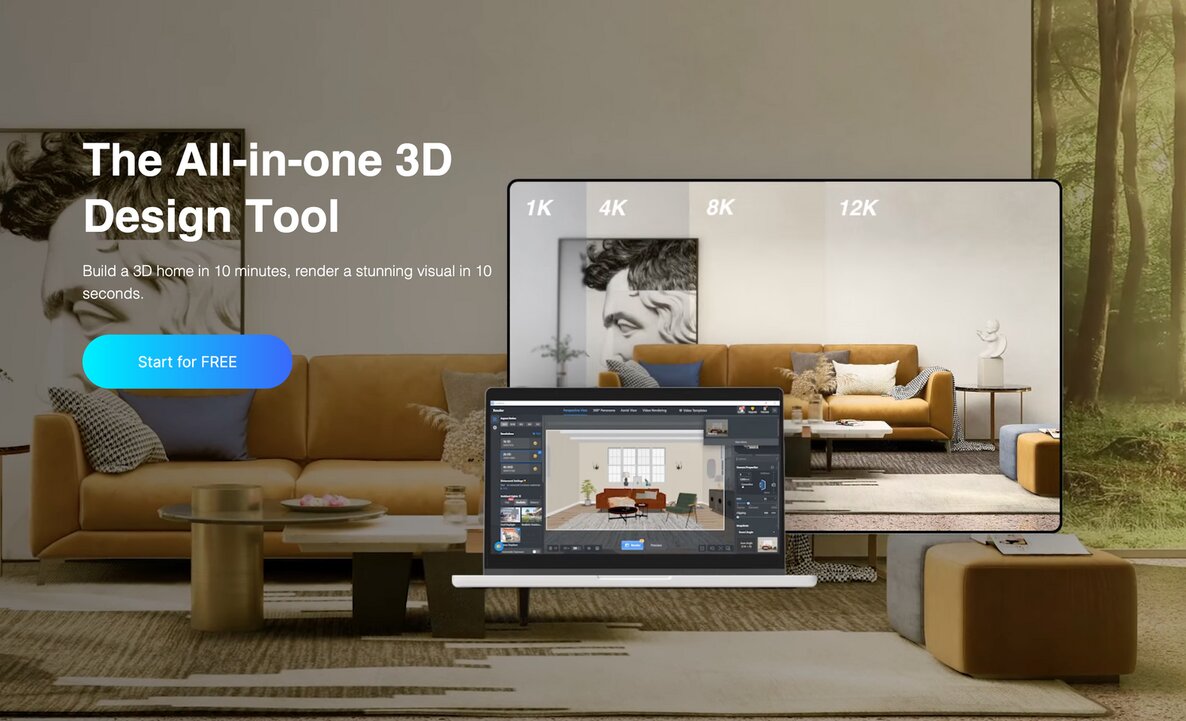How is 3D rendering software transforming the furniture buying experience? As technology advances, this question becomes increasingly relevant in the furniture industry. This blog post will delve into the intricate details of how design software is revolutionizing not only product visualization but also empowering designers to create striking modular furniture that reflects eclectic craftsmanship.
The benefits and challenges of implementing such advanced tools in the design process are significant. We’ll explore how these applications can help manufacturers easily create and sustain structural abnormalities in their designs, while also examining potential hurdles like creating physical prototypes for real-world testing.
We’ll also gaze into the future, speculating on what’s next for augmented reality and virtual reality within this sector. Will they become essential components of every office furniture project or remain as optional extras? Join us as we explore these questions and more about how 3D rendering software is transforming the furniture buying experience.
What is 3D Rendering Software?
3D rendering software serves as the digital magic wand in modern-day furniture shopping, making the entire process not only less puzzling but also an enjoyable journey of design discovery.
Understanding 3D Rendering Software
3D rendering software is essentially a sophisticated tool that generates photorealistic images from computer models using complex algorithms and simulated lighting. It’s a seamless blend of technology and creativity, akin to casting a spell that brings a virtual world to life.
Over recent years, the furniture industry has embraced the power of 3D rendering, presenting consumers with virtual representations of their desired pieces. Gone are the days of guessing whether a particular couch would be the right fit for your living room – you can now render a 3D image of it and see how it would look in real life!
The Role of 3D Rendering Software in Furniture Buying
3D renderings are revolutionizing the furniture buying experience, transforming it from static image viewing to an immersive, interactive exploration. You can examine furniture from every angle, tailor details according to your preference, and place it virtually in your space. It’s like conducting your own creative experiment, similar to playing The Sims, but with tangible, real-life outcomes.
Retailers leveraging this technology are witnessing significant decreases in return rates while simultaneously enhancing customer satisfaction. Now, you can shop online with absolute certainty, visualizing exactly how that sleek coffee table will complement your living room decor.
Benefits of 3D Rendering Software
The world of furniture buying has been revolutionized by the advent of 3D rendering software. This technology offers a myriad of benefits that significantly enhance the customer experience, making it easier than ever to visualize and customize your dream home furnishings.
Improved Visualization
Gone are the days of relying on flat, boring images or long-winded descriptions. With 3D rendering software, you can see furniture from every angle and even place it in your space using augmented reality. It’s like having X-ray vision for your home decor.
Better Customization Options
Forget settling for the same old colors and sizes. With 3D rendering, you can personalize furniture to your exact specifications. Want a purple couch? No problem. It’s like having a personal interior designer at your fingertips.
Informed Decision-Making
Why play a guessing game when you can see exactly what you’re getting? 3D rendering software lets you make informed choices before hitting that “buy” button. No more surprises or regrets – just pure satisfaction.
Saving Time and Money
Who has time to wander around stores or wait for swatches? With 3D rendering, you can shop from the comfort of your couch and get an accurate preview of your future furniture. Plus, many companies offer cost calculators, so you know exactly what you’re paying upfront. No hidden fees, no funny business.
All things considered, 3D rendering software is a game-changer for furniture shopping. It’s like having a crystal ball for your home decor dreams. So why settle for anything less?
Navigating the Complexities of 3D Rendering Software
While 3D rendering software brings unprecedented value to the furniture-buying journey, it’s important to acknowledge that like any technology, it does present certain challenges. However, these are not insurmountable hurdles, but areas where users can grow and adapt.
Understanding and Mastering the Software
One of the primary challenges lies in comprehending and effectively utilizing the software. Although designed with user-friendly interfaces, harnessing the full potential of these advanced tools does require a certain level of technical understanding. But don’t be daunted; it’s not a question of high IQ but rather patience and willingness to learn. With ample resources available online, even the most technologically averse can gradually become adept at using these tools.
Affordability and Accessibility
Another point of consideration is the cost factor. High-end solutions might seem out of reach for small businesses or individual users. However, the market offers a wide spectrum of solutions, including cost-effective alternatives. With diligent research, you can find software that aligns with your budget and needs.
Hardware and Internet Requirements
Moreover, creating detailed and high-quality renderings necessitates robust hardware and high-speed internet access. While this might present a challenge in areas with limited resources, the expanding availability of high-speed internet and advancements in affordable computing are gradually bridging this gap.
While these factors might seem daunting initially, they should not overshadow the transformative impact of 3D rendering software on the furniture-buying experience. Remember, every revolution brings its own set of challenges, and it’s through overcoming these that we truly appreciate the value and potential of technological advancement.
The Future of 3D Rendering Software
The future of 3D rendering software in the furniture buying experience is looking bright and exciting. As technology advances, we can expect this software to get even fancier, offering more perks for consumers.
Predicted Technological Advancements
In terms of technology, experts predict that 3D rendering will keep getting better, making virtual furniture look more realistic than ever. This means customers can easily imagine how these pieces will fit into their homes.
We might also see more options for customization. Right now, you can change colors and materials, but in the future, you could have the power to tweak dimensions and design features at a super detailed level.
Integration with Augmented Reality (AR)
A game-changing development on the horizon is the integration of 3D rendering with Augmented Reality (AR). AR lets you overlay digital information onto the real world through devices like smartphones or tablets. When combined with top-notch 3D renderings, this could revolutionize online furniture shopping by letting you virtually ‘place’ items in your own living space before buying.
User-friendly Interfaces and Accessibility
Developers are also working on making these tools more user-friendly and accessible. It’s not just about impressive visuals; it’s about making sure everyone, regardless of tech skills, can use them effectively.
Tackling Challenges: Cost & Complexity
The cost of using advanced tech like 3D rendering may change over time, becoming more affordable for businesses of all sizes, including small ones like Archic Furniture luxury e-commerce store. And to tackle complexity, providing training resources and intuitive interfaces will help anyone get started easily; no extensive tech knowledge is required.
So while challenges exist, they’re being actively addressed, paving the way for an exciting future.
FAQs
How has 3D product visualization software helped businesses?
The use of 3D product visualization software has revolutionized businesses by enabling realistic representation of products, facilitating better customer understanding, and boosting sales.
How does rendering software help designers improve their work?
Rendering software allows designers to create lifelike images, experiment with different designs, and visualize the final outcome before production, enhancing creativity and efficiency.
What are the benefits of 3D rendering?
The benefits of 3D rendering include an accurate depiction of design concepts, cost-effectiveness through reduced physical prototyping needs, improved communication with clients, and increased marketability.
What is 3D furniture rendering?
Furniture Rendering, a subset of 3D rendering, focuses on creating realistic images of furniture to help designers and customers visualize the final product.
Conclusion
In conclusion, 3D rendering software is changing the furniture game – giving customers a realistic sneak peek and saving everyone time and resources.
Social Contact:
LinkedIn | Facebook | Instagram | Twitter | YouTube
Media Contact:
>>> Schedule a DEMO!

